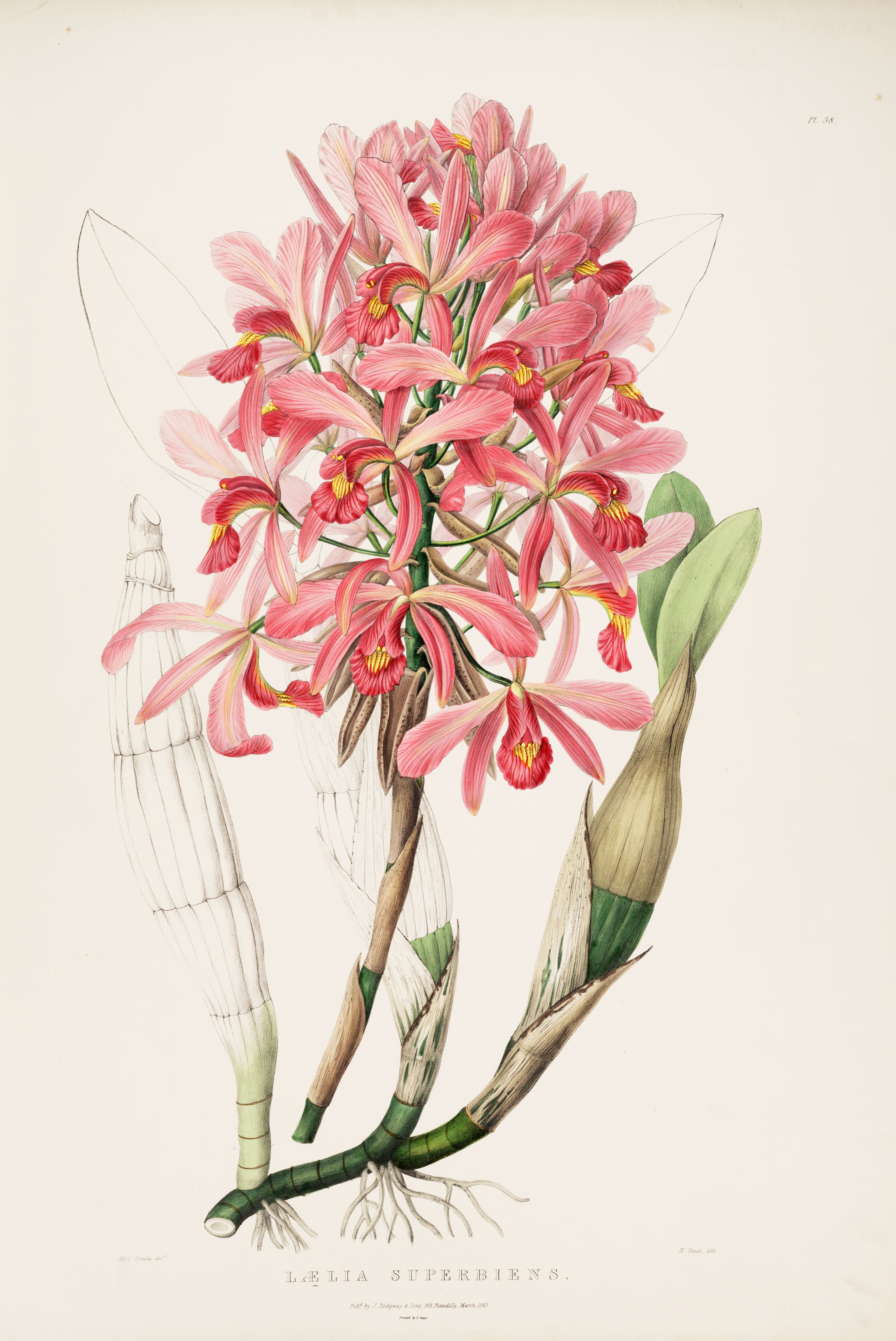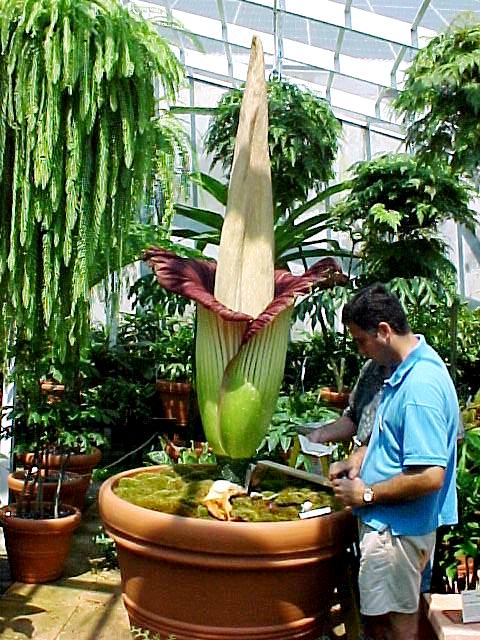|
Sympodial
In botany, sympodial growth is a bifurcating branching pattern where one branch develops more strongly than the other, resulting in the stronger branches forming the primary shoot and the weaker branches appearing laterally. A sympodium, also referred to as a sympode or pseudaxis, is the primary shoot, comprising the stronger branches, formed during sympodial growth. The pattern is similar to dichotomous branching; it is characterized by branching along stems or hyphae. Sympodial growth occurs when the apical meristem is terminated and growth is continued by one or more lateral meristems, which repeat the process. The apical meristem may be consumed to make an inflorescence or other determinate structure, or it may be aborted. Types If the sympodium is always formed on the same side of the branch bifurcation, e.g. always on the right side, the branching structure is called a helicoid cyme or bostryx. If the sympodium occurs alternately, e.g. on the right and then the ... [...More Info...] [...Related Items...] OR: [Wikipedia] [Google] [Baidu] |
Dichotomous Branching
This glossary of botanical terms is a list of definitions of terms and concepts relevant to botany and plants in general. Terms of plant morphology are included here as well as at the more specific Glossary of plant morphology and Glossary of leaf morphology. For other related terms, see Glossary of phytopathology, Glossary of lichen terms, and List of Latin and Greek words commonly used in systematic names. A B ... [...More Info...] [...Related Items...] OR: [Wikipedia] [Google] [Baidu] |
Orchidaceae
Orchids are plants that belong to the family (biology), family Orchidaceae (), a diverse and widespread group of flowering plants with blooms that are often colourful and fragrant. Orchids are cosmopolitan distribution, cosmopolitan plants that are found in almost every habitat (ecology), habitat on Earth except glaciers. The world's species richness, richest diversity of orchid genera and species is in the tropics. Orchidaceae is one of the two largest families of flowering plants, the other being the Asteraceae. It contains about 28,000 currently accepted species in 702 genera. The Orchidaceae family encompasses about 6–11% of all species of seed plants. The largest genera are ''Bulbophyllum'' (2,000 species), ''Epidendrum'' (1,500 species), ''Dendrobium'' (1,400 species) and ''Pleurothallis'' (1,000 species). It also includes ''Vanilla (genus), Vanilla'' (the genus of the Vanilla planifolia, vanilla plant), the type genus ''Orchis'', and many commonly cultivated plants s ... [...More Info...] [...Related Items...] OR: [Wikipedia] [Google] [Baidu] |
Inflorescence
In botany, an inflorescence is a group or cluster of flowers arranged on a plant's Plant stem, stem that is composed of a main branch or a system of branches. An inflorescence is categorized on the basis of the arrangement of flowers on a main axis (Peduncle (botany), peduncle) and by the timing of its flowering (determinate and indeterminate). Morphology (biology), Morphologically, an inflorescence is the modified part of the Shoot (botany), shoot of spermatophyte, seed plants where flowers are formed on the axis of a plant. The modifications can involve the length and the nature of the internode (botany), internodes and the phyllotaxis, as well as variations in the proportions, compressions, swellings, adnations, connations and reduction of main and secondary axes. One can also define an inflorescence as the reproductive portion of a plant that bears a cluster of flowers in a specific pattern. General characteristics Inflorescences are described by many different charact ... [...More Info...] [...Related Items...] OR: [Wikipedia] [Google] [Baidu] |
Cyme (botany)
In botany, an inflorescence is a group or cluster of flowers arranged on a plant's stem that is composed of a main branch or a system of branches. An inflorescence is categorized on the basis of the arrangement of flowers on a main axis ( peduncle) and by the timing of its flowering (determinate and indeterminate). Morphologically, an inflorescence is the modified part of the shoot of seed plants where flowers are formed on the axis of a plant. The modifications can involve the length and the nature of the internodes and the phyllotaxis, as well as variations in the proportions, compressions, swellings, adnations, connations and reduction of main and secondary axes. One can also define an inflorescence as the reproductive portion of a plant that bears a cluster of flowers in a specific pattern. General characteristics Inflorescences are described by many different characteristics including how the flowers are arranged on the peduncle, the blooming order of the flowe ... [...More Info...] [...Related Items...] OR: [Wikipedia] [Google] [Baidu] |
Monopodial
Vascular plants with monopodial growth habits grow upward from a single point. They add leaves to the apex each year and the stem grows longer accordingly. The word ''Monopodial'' is derived from Greek language, Greek '', ''one'' and '', "foot", in reference to the fact that monopodial plants have a single trunk or stem. Orchidaceae, Orchids with monopodial growth often produce copious aerial roots that often hang down in long drapes and have green chlorophyll underneath the grey root coverings, which are used as additional photosynthetic organs. They do not have a rhizome or pseudobulbs so species adapted to dry periods have fleshy Succulent plant, succulent leaves instead. Flowers generally come from the stem between the leaves. With some monopodial species, the stem (the rhizome) might fork into two, but for all monopodial orchids this is not necessary for continued growth, as opposed to orchids with sympodial growth.''The Orchid Expert'', Dr. D. G. Hessayon, Expert Books, Transw ... [...More Info...] [...Related Items...] OR: [Wikipedia] [Google] [Baidu] |
Rhizome
In botany and dendrology, a rhizome ( ) is a modified subterranean plant stem that sends out roots and Shoot (botany), shoots from its Node (botany), nodes. Rhizomes are also called creeping rootstalks or just rootstalks. Rhizomes develop from axillary buds and grow horizontally. The rhizome also retains the ability to allow new shoots to grow upwards. A rhizome is the main stem of the plant that runs typically underground and horizontally to the soil surface. Rhizomes have nodes and internodes and auxiliary buds. Roots do not have nodes and internodes and have a root cap terminating their ends. In general, rhizomes have short internodes, send out roots from the bottom of the nodes, and generate new upward-growing shoots from the top of the nodes. A stolon is similar to a rhizome, but stolon sprouts from an existing stem having long internodes and generating new shoots at the ends, they are often also called runners such as in the strawberry plant. A stem tuber is a thickene ... [...More Info...] [...Related Items...] OR: [Wikipedia] [Google] [Baidu] |
Pseudobulb
In botany, a pseudobulb is a storage organ found in many epiphytic and terrestrial sympodial orchids. It is derived from a thickening of the part of a stem between leaf nodes and may be composed of just one internode or several, termed ''heteroblastic'' and ''homoblastic'' respectively. All leaves and inflorescences usually arise from this structure. Pseudobulbs formed from a single internode produce the leaves and inflorescence from the top, while those that are formed from several internodes can possess leaves along its length.Hew, C.S., and J.W.H. Yong. 2004The Physiology of Tropical Orchids in Relation to the Industry.Singapore: World Scientific Publishing Co. pp. 13-15. The modified sheath leaves that appear at the base of a pseudobulb and often enfold all or part of it are usually dry and papery, though in some orchids the sheaths bear leaf blades and the leaves at the pseudobulb's apex are reduced to scales.Dressler, R.L. 1993. Phylogeny and Classification of the Orchid F ... [...More Info...] [...Related Items...] OR: [Wikipedia] [Google] [Baidu] |
Laelia Superbiens RHS
''Laelia'' is a small genus of 25 species in the orchid family (Orchidaceae). ''Laelia'' species are found in areas of subtropical or temperate climate in Central and South America, but mostly in Mexico. ''Laelia'' is abbreviated ''L.'' in the horticultural trade. Description Mostly epiphyte herbs (with a few lithophytes) with laterally compressed pseudobulbs. One to four leathery or fleshy leaves are born near the top of each pseudobulb, and can be broadly ovate to oblong. The inflorescence is a terminal raceme (rarely a panicle). The flowers have 8 pollinia; petals are of a thinner texture than the sepals; sepals and petals are of similar shape, but the sepals being narrower; the lip or labellum is free from the arched flower column. Distribution Species of ''Laelia'' can be found from western Mexico south to Bolivia, from sea level to mountain forests. Taxonomy The genus ''Laelia'' was described as part of subfamily Epidendroideae by John Lindley. Brazilian ''Laelias'', a ... [...More Info...] [...Related Items...] OR: [Wikipedia] [Google] [Baidu] |
Botany
Botany, also called plant science, is the branch of natural science and biology studying plants, especially Plant anatomy, their anatomy, Plant taxonomy, taxonomy, and Plant ecology, ecology. A botanist or plant scientist is a scientist who specialises in this field. "Plant" and "botany" may be defined more narrowly to include only land plants and their study, which is also known as phytology. Phytologists or botanists (in the strict sense) study approximately 410,000 species of Embryophyte, land plants, including some 391,000 species of vascular plants (of which approximately 369,000 are flowering plants) and approximately 20,000 bryophytes. Botany originated as history of herbalism#Prehistory, prehistoric herbalism to identify and later cultivate plants that were edible, poisonous, and medicinal, making it one of the first endeavours of human investigation. Medieval physic gardens, often attached to Monastery, monasteries, contained plants possibly having medicinal benefit. ... [...More Info...] [...Related Items...] OR: [Wikipedia] [Google] [Baidu] |
Bifurcation
Bifurcation or bifurcated may refer to: Science and technology * Bifurcation theory, the study of sudden changes in dynamical systems ** Bifurcation, of an incompressible flow, modeled by squeeze mapping the fluid flow * River bifurcation, the forking of a river into its distributaries * Bifurcation lake, a lake that flows into two different drainage basins * Bifurcated bonding, a single hydrogen atom participates in two hydrogen bonds * Bifurcated stick grip, a type of aircraft control column Other uses * Bifurcation (law), the division of issues in a trial See also * Aortic bifurcation, the point at which the abdominal aorta bifurcates into the left and right common iliac arteries * Tracheal bifurcation, or the carina of trachea (Latin: ''bifurcatio tracheae'') * Bifurcation diagram * Bifurcate merging, a kinship system * False dilemma A false dilemma, also referred to as false dichotomy or false binary, is an informal fallacy based on a premise that erroneously limits wh ... [...More Info...] [...Related Items...] OR: [Wikipedia] [Google] [Baidu] |
Branch
A branch, also called a ramus in botany, is a stem that grows off from another stem, or when structures like veins in leaves are divided into smaller veins. History and etymology In Old English, there are numerous words for branch, including , , , and . There are also numerous descriptive words, such as (that is, something that has bled, or 'bloomed', out), (literally 'little bough'), (literally 'on growth'), and (literally 'offspringing'). Numerous other words for twigs and boughs abound, including , which still survives as the ''-toe'' in ''mistletoe''. Latin words for branch are or . The latter term is an affix found in other modern words such as '' cladodont'' (prehistoric sharks with branched teeth), ''cladode'' (flattened leaf-like branches), or ''cladogram'' (a branched diagram showing relations among organisms). Woody branches Large branches are known as boughs and small branches are known as twigs. The term ''twig'' usually refers to a terminus, while ''bou ... [...More Info...] [...Related Items...] OR: [Wikipedia] [Google] [Baidu] |






